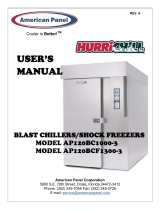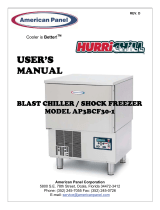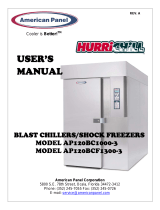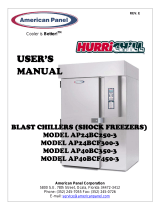Page is loading ...

REV. C
Cooler is Better!
TM
INSTALLATION,
OPERATION AND
MAINTENANCE
Manual
BLAST CHILLERS
MODEL AP40BC250-12
MODEL AP40BC250-2-12
MODEL BCCP-1
MODEL BCCP-2
MODEL BCIP
American Panel Corporation
5800 S.E. 78th Street, Ocala, Florida 34472-3412
Phone: (352) 245-7055 Fax: (352) 245-0726
E-mail: [email protected]

Thank you, and congratulations on your purchase of an American Panel blast chiller. We take great
pride in engineering and manufacturing each of our products. With the goal of providing the highest
accuracy and quality possible, our state-of-the-art manufacturing and quality control facility enables
us to continually explore new technologies so that we can provide you with the finest equipment in the
industry.
Because of our commitment to your satisfaction, we have developed this Installation, Operation, and
Maintenance manual to guide you through the complete installation process, and to help you maintain
your equipment properly. Familiarization and compliance with this manual will ensure you years of
trouble-free operation.
On occasion situations can arise and will require the help of the factory, whether it be technical
information, service or replacement of parts. We have a highly trained Customer Service and Parts
Department available to help when these situations arise. We also offer a national network of service
agencies that may be contacted for warranty and out-of-warranty service.
When contacting the factory, please refer to the equipment serial number which can be located on the
identification plate positioned on the side of the control panel.
Thank you once again for your purchase of American Panel equipment.
“Our reputation rests on the steadfast pursuit of your satisfaction”.
American Panel Corporation
5800 S.E. 78 th Street, Ocala, Florida 34472-3412
Phone: (352) 245-7055 Fax: (352) 245-0726
E-mail: [email protected]

INDEX
1
Index
Index.......................................................................................................................................................................................1
A. Introduction.........................................................................................................................................................................2
A.1. Controller Features......................................................................................................................................................2
B. Installation...........................................................................................................................................................................4
B.1. Initial Cabinet Preparation...........................................................................................................................................4
B.2. Single Unit Installation AP40BC250-12 And BCCP-1................................................................................................. 5
B.2.1. Install Coil Assembly Frame ................................................................................................................................5
B.2.2. Install Fan Assembly Frame ................................................................................................................................6
B.2.3. Electrical Connections .........................................................................................................................................8
B.3. Double Unit Installation AP40BC250-2-12, BCCP-2, And BCIP...............................................................................11
C. Refrigeration Unit Installation ...........................................................................................................................................13
C.1. Preparation................................................................................................................................................................13
C.2. Find The Location......................................................................................................................................................13
C.3. Refrigeration Lines Installation..................................................................................................................................14
C.3.1. Installation At The Same Level..........................................................................................................................15
C.3.2. Installation At Different Levels...........................................................................................................................15
C.4. Connect The Remote Unit.........................................................................................................................................15
D. Programming The Controller............................................................................................................................................17
D.1. Blast Chilling Modes..................................................................................................................................................17
D.2. PC Connection Mode................................................................................................................................................17
D.3. Programming Modes.................................................................................................................................................18
D.4. Initial Programming ...................................................................................................................................................18
D.4.1. Initial Programming Procedure And Parameters...............................................................................................18
D.5. Parameter Programming...........................................................................................................................................21
D.5.1. Parameter Programming For Automatic Cycle..................................................................................................21
D.5.2. Parameter Programming For Manual Cycle......................................................................................................22
D.5.3. Parameter Programming For Defrost Cycle......................................................................................................23
D.5.4. Parameter Programming For UV Cycle.............................................................................................................24
D.5.5. Parameter Programming For Print Cycle...........................................................................................................24
D.6. Programming The Alarms.........................................................................................................................................24
D.6.1. Setting The Food Probe Alarms ........................................................................................................................25
D.6.2. Setting The Air Probe Alarm..............................................................................................................................25
D.7. Recipe Names........................................................................................................................................................... 25
E. Printer (Optional) ..............................................................................................................................................................26
E.1. Loading A Roll Of Paper............................................................................................................................................26
E.2. Removing A Roll Of Paper........................................................................................................................................26
E.3. Operating The Printer................................................................................................................................................ 26
E.4. Maintenance..............................................................................................................................................................26
E.5. Replacing The Ribbon (No Paper In The Printer)..................................................................................................... 26
E.6. Replacing The Ribbon (With Paper In The Printer)...................................................................................................26
E.7. Clear The Events Memory.........................................................................................................................................27
F. Operating And Maintaining The Unit.................................................................................................................................28
F.1. Panning And Loading................................................................................................................................................28
F.2. Operating...................................................................................................................................................................29
F.2.1. Automatic Cycle .................................................................................................................................................29
F.2.2. Manual Cycle......................................................................................................................................................29
F.2.3. Defrost Cycle......................................................................................................................................................30
F.2.4. UV Cycle ............................................................................................................................................................31
F.2.5. Print Cycle..........................................................................................................................................................31
F.2.6. Error Messages And Troubleshooting................................................................................................................32
F.3. Maintenance And Cleaning .......................................................................................................................................33
G. Standard Warranty...........................................................................................................................................................34
Appendixes..........................................................................................................................................................................35
Appendix 1 Settings Record for AP40BC250-12, AP40BC250-2-12, BCCP-1, BCCP-2, and BCIP ...............................35
Appendix 2 Electrical Schematic 1 ...................................................................................................................................36
Appendix 3 Electrical Schematic 2 ...................................................................................................................................37
Appendix 4 Parts List........................................................................................................................................................38
Appendix 5 Ordering Printer Supplies (Ribbon & Paper) ................................................................................................. 39

INTRODUCTION
2
A. Introduction
The Models AP40BC250-12, AP40BC250-2-12, BCCP-1, BCCP-2, and BCIP Blast Chillers are used to rapidly
chill cooked foods to temperatures suitable for storage in a refrigerator. Blast chillers are sophisticated refrigeration
machines capable of lowering the core temperature of most foods from 160°F to 38°F in less than two hours. Blast chilling
operations employ high velocity cooled air flow to assure even cooling of the entire food product, and to quickly bring the
food temperature through the danger zone in which bacteria multiply rapidly. This is done in accordance with HACCP,
FDA and all state regulations. A dual temperature chilling cycle allows use of standard recipes without modification.
A.1. Controller Features
A solid state electronic controller, conveniently mounted on the front panel of the unit, is used to program and to
operate the unit. Full controller instructions follow, covering:
• initial set-up (done at time of installation)
• programming of the cycles (done before operation and changed only if foods or conditions are
changed)
• operator selection from several available choices of operating mode
• operation
The versatility of the controller allows the operator to choose from the following modes and cycles:
1. AUTOMATIC MODE, the preferred mode, in which all the food probes are active and take part in controlling the
chilling process. The cycle will never proceed to its next step until all the probes have reached their set temperatures. The
operator needs only to select the recipe number of the food to be controlled by each probe (up to 150 recipes can be
programmed), then insert each probe into its food. When all the probes have reached their programmed temperatures, the
unit will automatically switch into holding mode.
2. MANUAL MODE, in which operating time is manually set by the operator for a particular meal. Air temperature
is controlled by the air probes. The food probes, if they have been inserted into the food, will provide temperature readouts
only. Manual mode will also switch automatically into the holding mode at the end of the cycle.
3. DEFROST CYCLE, used to defrost the unit if there has been a build-up of ice.
4. UV CYCLE (OPTIONAL), for sanitizing the unit.
5. PRINTER (OPTIONAL), which may be programmed to print or not print during the chilling cycles. If the printer
is selected, printing starts automatically at the beginning of each chill cycle. All the operating parameters (starts and stops
of the chilling cycle, dates and times, air and food temperatures) are printed, and then repeated in accordance with the
programmed printer cycle time. If the printer is not selected, the readings will be stored for printing at a later time (up to
250 events, corresponding to one week of normal usage, can be stored). Refer to the instructions in this manual, as well
as in the printer’s manual, for more details.
NOTE: Be certain to complete and return the printer’s warranty card. Also retain the ribbon & paper order form for
use when needed.

CONTROLLER
3

INSTALLATION
4
B. Installation
American Panel Corporation equipment has been shipped in a package designed to sufficiently protect from
damage under normal shipping circumstances.
Upon receiving the shipment, carefully inspect the package for visible damage and check the number of packages against
the Bill of Lading. Notify the carrier immediately of any shortage or damage to your shipment. Claims must be filed
promptly with the carrier.
After receipt of shipment, carefully and safely remove the unit from the package. Check the containing of the
package against the packing list.
Under no circumstances may a damaged piece of equipment be returned to American Panel Corporation without
first obtaining written permission.
To assure proper installation carefully read and comply with the following instructions.
B.1. Initial Cabinet Preparation
Note: When following the installation instructions consider that the fan assembly frame will be inserted into door hinge
side of cabinet and the coil assembly frame will be inserted in the door latch side of cabinet.
Check if the cabinet was provided with penetrations to accommodate the refrigeration pipes (2-1/2” hole) and the
drainpipe (1-1/2” hole). If the cabinet is provided with penetrations proceed with the installation of the coil assembly frame.
Otherwise follow the next steps:
1. Measure location of drainpipe on drain pan (see PHOTO #1) where it will extend behind the Coil Assembly Frame
(see PHOTO #3, page 9). Properly cut a corresponding 1 ½” hole in the rear corner panel to receive the drainpipe
(see DRAWING #1).
PHOTO # 1
DRAWING # 1
2. Measure and locate the refrigeration lines on the coil assembly frame and properly drill corresponding 2 ½” holes
in the ceiling side or rear panels to accommodate 1 1/8” and ½” pipes.
3. Install the air deflectors on the top corners (above the fan and coil frames) using the provided self-taping stainless
steel screws.

INSTALLATION
5
B.2. Single Unit Installation AP40BC250-12 And BCCP-1
B.2.1. Install Coil Assembly Frame
DRAWING # 2
1. Insert the coil assembly frame into the door latch side of
the box with the filter facing the interior of the box (see
DRAWING # 2). Push the assembly tight to the side wall
leaving ¼” space at the front and rear panels.
Note the three holes on the stainless steel angle frame (at
the top of the horizontal cross brace on the vertical surface
at the back of the frame). Drill 1/8” pilot holes.
DRAWING # 3
2. Secure the frame to the back of the box with self-tapping 8/32” stainless steel screws (see DRAWING # 3).
3. Insert the drain pan (see PHOTO #1, page 4) with the drain pipe through the drain hole previously drilled.

INSTALLATION
6
B.2.2. Install Fan Assembly Frame
1. Insert the fan assembly frame into the door hinge side of the box with the fans facing the interior of the box (see
DRAWING # 4). Push the assembly tight to the side wall leaving ¼” space at the front and rear panels.
Note the three holes on the stainless steel angle frame (at the top of the horizontal cross brace on the vertical
surface at the back of the frame). Drill 1/8” pilot holes into the back panel of the box.
2. Secure the frame to the back of the box with self-tapping 8/32” stainless steel screws (see DRAWING # 3, page 5)
DRAWING # 4

INSTALLATION
7
PHOTO #2
3. Seal the spaces between frames and side box panels by
tightening the butterfly ¼” nuts on the provided seal
brackets (see PHOTO #3 page 8).
4. Make the electrical connections (page 8) and install the
refrigeration unit (page 13).
5. Lower the ceiling panel over the Coil Assembly Frame
and secure the ceiling to the fans top filler panel with 8/32”
bolts in the predrilled holes (see DRAWING # 5 & PHOTO
#2). Drill holes in the coil side of the ceiling through the coil
filler and secure with self-taping 8/32” stainless steel
screws.
DRAWING # 5

INSTALLATION
8
PHOTO #3
B.2.3. Electrical Connections
All power cables inside the cabinet, with the exception of door / window heater and door switch cables (see
PHOTO #4, page 10), are provided with twist and lock plugs and connectors. All cables, plugs, and connectors are color
coded (see Color Code Chart on page 9). Connect the plugs and connectors of the same code color (see PHOTO #5,
page 10).
According to the color code chart, the orange coded cable is for the door / window heater. Connect this cable with
the door and window heaters inside the connection box provided by the box supplier. Connect the brown cable with the
door switch using heat shrink butt splices.
The thermocouple cables (gray) are provided for the air probe(s), food probe(s), and defrost probe. Connect the red,
yellow, green, and blue cables in the terminal block on the top of the evaporator assembly (see PHOTO #6, page 11). The
brown cable is for the air probe located behind the top fan. The white cable is for the defrost probe located on the bottom
of the evaporator. Use heat shrink butt splices. Hang all cables so they will not touch the defrost heaters and will not be
caught by the fan blades. Install the thermostat bulb on the coil assembly frame as close to the defrost heaters as possible
but not closer than 5”. Secure the bulb of the thermostat with cable ties to minimize risk of breakage of the capillary tube
caused by vibration.
NOTE: If the door switches are not installed by the box supplier, mount the ones provided by American Panel
Corporation as shown on page 9, DRAWING #6 and page 12, PHOTO #7.

INSTALLATION
9
COLOR CODE CHART
PLUG/CONNECTOR
COLOR
PLUG/CONNECTOR DESTINATION
CABLE/WIRE
TYPE
QUICK-CONNECT (PLUG-CONNECTOR) CABLES
BLUE FANS SOOW
YELLOW DEFROST HEATERS SOOW
GRAY SOLENOID VALVE SOOW
WHITE INTERIOR LIGHT SOOW
GREEN UV LIGHT SOOW
BROWN DOOR SWITCH SOOW / WIRE
ORANGE DOOR / WINDOW HEATERS SOOW / CONN. BOX
RTD (FOOD, AIR & DEFROST) PROBES (GREY WIRE)
GREEN PRODUCT PROBE THERMOCOUPLE (OPTIONAL)
BLUE PRODUCT PROBE THERMOCOUPLE (OPTIONAL)
YELLOW PRODUCT PROBE THERMOCOUPLE (OPTIONAL)
RED PRODUCT PROBE THERMOCOUPLE (STANDARD)
BROWN AIR PROBE THERMOCOUPLE (STANDARD)
WHITE DEFROST PROBE THERMOCOUPLE (STANDARD)
DRAWING #6
NOTE: Route the micro-switch (B) wires through the wall and bring them inside the box at approx. 6” above
the door. Insulate the wall hole (s) with silicone or grommets. Take precaution to protect the heater wires
inside the door frame.

INSTALLATION
10
PHOTO #4
PHOTO #5

INSTALLATION
11
PHOTO #6
B.3. Double Unit Installation AP40BC250-2-12, BCCP-2, And BCIP
Installation procedures are similar with the ones for the single unit. Each of the two evaporators is fed by one
condensing unit.
Both single units installed in a double box are controlled by one electronic controller. The difference is made by
the double number of power cables and air probe cables. The two frames to be installed by the control board are marked
# 1. The other two frames to be installed on the back are marked # 2 (see PHOTO #8 page 12 and PHOTO #9, page 13).
If the markings are lost or missing and you need to select the frames to be installed close to the controller, look for the
ones with extra long cables. If the frames are installed improperly, the feeding cables will be short. Drill holes through the
partition walls above the top of the frames. Run the cables with connectors through, and plug them according to the color
codes. Protect the cables from the rough edges of the drilled holes into the partition walls.

INSTALLATION
12
PHOTO #7
Door magnetic switch on the left; Magnet on the right
PHOTO #8

INSTALLATION
13
PHOTO #9
C. Refrigeration Unit Installation
C.1. Preparation
9 Check the integrity of the unit once it is unpacked
9 Check to make sure the floor is leveled
9 Check that the available power supply corresponds to the ratings on the unit’s nameplates and correctly rated
electrical protection is provided.
9 If additional refrigerant should be needed, be certain to use the correct type.
9 Make certain that adequate drainage is provided.
9 If a remote condensing unit is used, be certain that it is positioned within the range indicated in this manual and that it
is connected as specified and in accordance with all applicable electrical codes.
C.2. Find The Location
Ambient air temperature for air-cooled condensing units must be no greater than 95° F to ensure the rated performance.
The condensing unit must be located away from direct sunlight if installed outdoors; or, if it is indoors, it should be in an
appropriate room in which air change is guaranteed to be no less than 318,000 cubic feet per hour.
SPECIFICATIONS TO USE DURING INSTALLATION:
i) CABINET
AP40BC250-12
BCCP-1
AP40BC250-2-12
BCCP-2, BCIP
ii) AIR COOLED
REMOTE CONDENSING UNIT
(4HP)(OPTIONAL)
Voltage 120/208V 120-208V 208V
Phases 1 1 3
Amperage 10 20 20
Circuit size 15 30 30
Power supply cable 12-4 10-4 10-4
Note: The condensing unit and the cabinet must be connected to separate

INSTALLATION
14
electrical power supplies.
Each wire must be connected to its corresponding terminal.
The ground wire must be connected to an efficient ground terminal.
C.3. Refrigeration Lines Installation
Follow the steps below to assure a proper installation.
1. Minimum pipe inclination has to be provided.
CONDENSING UNIT
2. Make sure you place the fastening brackets on insulated piping.
3. Provide air tight welding.
4. Create the vacuum and load the line.
5. Check for leaks.
6. Open the shut-off valves (A & B) on both sides of remote unit and of cabinet.
7. Check the exact load of refrigerant in the liquid passage gauge.
8. Check that all the refrigerant taps are open.
Use the table below to determine the number of pipe supports you need to install.

INSTALLATION
15
Distance (ft.) Number of Pipe Supports
16 2
32 3
48 5
64 7
80 9
C.3.1. Installation At The Same Level
If the condensing unit is going to be installed at the same level with the cabinet, follow the instructions in the FIG #5
FIG # 5
C.3.2. Installation At Different Levels
If the remote condensing unit is installed at a higher level than the cabinet (FIG #6) insert a siphon in the return
line at every 6 ft. of difference in height. If the remote condensing unit is installed at a lower level than the cabinet (FIG #7)
it is not necessary to insert any siphons.
FIG #6 FIG #7
Insert a siphon at the beginning (a) and at the end (b) of each riser
C.4. Connect The Remote Unit

INSTALLATION
16
The specified piping diameters (see chart below) from the remote condensing unit to the cabinet is adequate for a
separation of up to 60 feet. For greater distances, contact the factory for instructions.
Diameter of Copper Piping
Supply Line ½”
Intake Line 1 1/8”
**Note: The insulation used on the piping must be of high quality and must have
closed cells.
CONDENSATE DRAINAGE CONNECTION
It is important that condense from the evaporator is properly drained. The drain line from the evaporator exits from
the side of the front cabinet. It must be connected in conformance with local regulations.
VERIFYING CORRECT INSTALLATION
1. Check that there are no refrigerant leaks from welds and joints that were done during the installation.
2. Check that the refrigerant piping is insulated fully and correctly.
3. Check all electrical connections.
4. Check the provision for drainage of condense.
5. Check that the electrical supply is the correct voltage (within ± 5%), phase and size per the nameplate.

PROGRAMMING
17
D. Programming The Controller
WARNINGS!
Read and carefully follow all of the instructions in this manual before attempting to install this equipment.
Installation must be performed by a qualified Service Agency approved and authorized by American Panel
Corporation. Doing otherwise may void the warranty.
Any changes made to the equipment without authorization from the factory will void the warranty.
PREPARATION
9 Check the integrity of the unit once it is unpacked.
9 Check to make sure the floor is level.
9 Check that the available power supply (Voltage, # of phases, Hz, Amps, max. fuse size) corresponds to the ratings on
the nameplate and that correctly rated electrical protection is provided (VOLTAGE MUST BE WITHIN ± 5% FROM
THE NAMEPLATE VALUE).
9 Make certain that adequate drainage is provided.
D.1. Blast Chilling Modes
AP40BC250-12, AP40BC250-2-12, BCCP-1, BCCP-2, and BCIP are equipped with a high versatility electronic
controller allowing the chef to choose between automatic and manual operation.
Automatic Mode
In the first part of the cycle the air temperature is lowered to a preset temperature (10
0
F). When the food core
temperature reaches a preset breaking temperature point (60
0
F) the unit will switch to the second part of the cycle which
is design to protect the food from getting frozen. The air temperature will rise to a preset temperature range (28
0
F to
35
0
F). The chilling cycle is complete when the food core temperature reaches the desired end temperature (40
0
F).
Manual Mode
In the manual mode the blast chilling operation will last for a preset time. In the first part of the manual cycle the
air temperature is lowered and held to a preset temperature (10
0
F). Once the time for the first part of the cycle expires the
unit will switch to the second part of the cycle. The air temperature is held at a preset temperature range (28
0
F to 35
0
F) for
the remaining time (1 hour).
Note: At the end of any blast chilling cycle the unit will automatically switch to a holding mode which will keep the food at
38
0
F until START/STOP button is pressed to end the cycle.
D.2. PC Connection Mode
The unit can be programmed and operated from a remote PC via modem and software (Windows 95, 98, 2000,
NT, and XP). Maximum distance is 4000 feet. Full instructions are supplied on a computer disc, which is furnished when
the computer connection is ordered. All connections should be made exactly as shown in the connection diagram, drawing
number 98002-01B on page 38 of this manual.
The application allows the operator to save the programmed parameters and the events memory to PC for
archival purposes. The software’s interface emulates the control panel.

PROGRAMMING
18
D.3. Programming Modes
All American Panel Corporation blast chillers are initially programmed at the factory. These settings may be
considered standard for AP40BC250-12, AP40BC250-2-12, BCCP-1, BCCP-2, and BCIP units. However, the customer
may change any of these settings as indicated by necessity.
There are two programming modes to be covered:
Initial Programming - settings like year, month, date, time, and several other parameters.
Parameter Programming - settings that control the chilling cycles.
To program the controller the customer can either use the control panel at the unit, or the PC application.
The front panel buttons are divided into 3 groups, as follows:
1. 3.
On/Off
Select
Start/Stop
Up
2.
Automatic Cycle
Down
Manual Cycle
Enter
Defrost Cycle
UV Cycle
Print
D.4. Initial Programming
The initial configuration of the system can be performed in Initial Programming mode. This includes setting the
current year, month, date and time, as well as several other parameters.
Note: During the programming steps, any delay longer than 20 seconds before pushing the next button will cause the
controller to revert to “OFF” state and the display will show: OFF. TO AVOID THIS, THE FOLLOWING INSTRUCTIONS
SHOULD BE CAREFULLY REVIEWED AND THE DESIRED SETTINGS SHOULD BE DETERMINED BEFORE
PROCEEDING.
If the control panel goes to OFF state, programming mode will have to be restarted.
Note: During programming, pressing and holding
or button for more than two seconds will increase the value
changing speed.
D.4.1. Initial Programming Procedure And Parameters
The instructions below contain screens with the exact messages displayed by the controller during programming
procedure. Follow the notes located to the right of these screens.
Check that the unit is plugged in and power is available. The controller should be in
OFF state. If it is not, press
.
Press and hold
for approximately 5 seconds. When the command is accepted, the controller will give one long beep
and ask the operator to select the desired language. Use
and buttons to scroll thru the language settings.
Press
when done.
/




